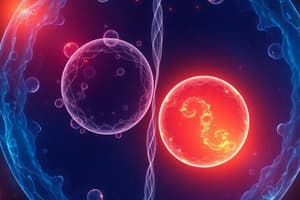Podcast
Questions and Answers
What is the chromosome number in a cell before it splits during mitosis?
What is the chromosome number in a cell before it splits during mitosis?
- 46 chromosomes (correct)
- 46 chromatids (correct)
- 92 chromatids (correct)
- All of the above
What is the chromosome number in a cell after it splits during meiosis?
What is the chromosome number in a cell after it splits during meiosis?
- 92 chromatids (correct)
- both A and C
- 23 chromosomes (correct)
- 46 chromosomes
What happens during interphase?
What happens during interphase?
The chromosomes are in their normal routine waiting for mitosis.
How many times does interphase occur during mitosis?
How many times does interphase occur during mitosis?
How many times does interphase occur during meiosis?
How many times does interphase occur during meiosis?
What types of cells do not undergo mitosis?
What types of cells do not undergo mitosis?
Name two ways that mitosis is important for your body.
Name two ways that mitosis is important for your body.
What type of cells are produced in mitosis?
What type of cells are produced in mitosis?
Describe what occurs if cells are in mitosis more than in interphase.
Describe what occurs if cells are in mitosis more than in interphase.
What are chromosomes made of?
What are chromosomes made of?
How many chromosomes should be in each diploid cell after mitosis in humans?
How many chromosomes should be in each diploid cell after mitosis in humans?
How many chromosomes are in a sperm or egg cell?
How many chromosomes are in a sperm or egg cell?
What would happen if interphase didn't occur before meiosis?
What would happen if interphase didn't occur before meiosis?
How can you know if two chromosomes are homologous?
How can you know if two chromosomes are homologous?
What happens during crossing over in meiosis?
What happens during crossing over in meiosis?
How can you determine if the cell is in metaphase I or metaphase II?
How can you determine if the cell is in metaphase I or metaphase II?
What is nondisjunction?
What is nondisjunction?
Finish the meiosis chain with the correct stages.
Finish the meiosis chain with the correct stages.
What type of cells does mitosis end with?
What type of cells does mitosis end with?
What do both mitosis and meiosis have in common?
What do both mitosis and meiosis have in common?
What is the primary purpose of meiosis?
What is the primary purpose of meiosis?
What does meiosis produce?
What does meiosis produce?
Flashcards are hidden until you start studying
Study Notes
Mitosis
- Begins with 46 chromosomes and 46 chromatids before splitting, resulting in two diploid cells each with 46 chromosomes and 46 chromatids.
- Interphase occurs once before mitosis, during which the cell prepares for division.
- Mitosis is essential for growth and repair of body cells.
- Produces identical cells, maintaining the same chromosome number (diploid).
- Chromosomes are made of DNA and proteins, ensuring equal distribution during cell division.
Meiosis
- Starts with 46 chromosomes, resulting in four haploid cells each with 23 chromosomes after two rounds of division (meiosis I and II).
- Interphase occurs once before meiosis, allowing for growth before reproduction.
- Gametes (sperm and egg cells) are produced, each containing 23 chromosomes.
- Crossing over occurs in prophase I, exchanging genetic material between homologous chromosomes, leading to genetic diversity.
- Nondisjunction can occur, resulting in uneven distribution of chromatids to daughter cells, which can lead to genetic disorders.
Interphase
- Key preparatory phase shared by both mitosis and meiosis.
- Without interphase, cells would replicate excessively and fail to produce necessary proteins.
Homologous Chromosomes
- Chromosomes are considered homologous if they share the same structure and genetic purpose, pairing together during meiosis.
Chromosome Structure
- Composed of DNA and proteins, chromosomes play a crucial role in genetic inheritance during cell division.
Differences Between Mitosis and Meiosis
- Mitosis results in two diploid cells; meiosis results in four haploid gametes.
- Mitosis is involved in growth and tissue repair, while meiosis is vital for sexual reproduction and genetic variation.
Studying That Suits You
Use AI to generate personalized quizzes and flashcards to suit your learning preferences.





